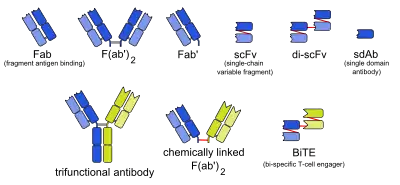Antibody mimetic
Antibody mimetics are organic compounds that, like antibodies, can specifically bind antigens, but that are not structurally related to antibodies. They are usually artificial peptides or proteins with a molar mass of about 3 to 20 kDa. (Antibodies are ~150 kDa.)
Nucleic acids and small molecules are sometimes considered antibody mimetics as well, but not artificial antibodies, antibody fragments and fusion proteins composed from these.
Common advantages over antibodies are better solubility, tissue penetration, stability towards heat and enzymes, and comparatively low production costs. Antibody mimetics are being developed as therapeutic and diagnostic agents.[1]
Examples
| Antibody mimetic | Scaffold | Molar mass | Example drug |
|---|---|---|---|
| Affibody molecules[2] | Z domain of Protein A | 6 kDa | ABY-025 |
| Affilins[3] | Gamma-B crystallin | 20 kDa | |
| Ubiquitin | 10 kDa | SPVF 2801 | |
| Affimers[4] | Cystatin | 12–14 kDa | |
| Affitins[5] | Sac7d (from Sulfolobus acidocaldarius) | 7 kDa | |
| Alphabodies[6] | Triple helix coiled coil | 10 kDa | CMPX-1023 |
| Anticalins[7] | Lipocalins | 20 kDa | |
| Avimers[8] | A domains of various membrane receptors | 9–18 kDa | |
| DARPins[9] | Ankyrin repeat motif | 10–19 kDa | MP0112 |
| Fynomers[10] | SH3 domain of Fyn | 7 kDa | |
| Kunitz domain peptides[11] | Kunitz domains of various protease inhibitors | 6 kDa | Ecallantide (Kalbitor) |
| Monobodies[12] | 10th type III domain of fibronectin | 10 kDa | Pegdinetanib (Angiocept) |
| nanoCLAMPs[13] | Carbohydrate Binding Module 32-2 (from Clostridium perfringens NagH) | 16 kDa |
See also
References
- Gebauer M, Skerra A (June 2009). "Engineered protein scaffolds as next-generation antibody therapeutics". Curr Opin Chem Biol. 13 (3): 245–255. doi:10.1016/j.cbpa.2009.04.627. PMID 19501012.
- Nygren PA (June 2008). "Alternative binding proteins: affibody binding proteins developed from a small three-helix bundle scaffold". FEBS J. 275 (11): 2668–76. doi:10.1111/j.1742-4658.2008.06438.x. PMID 18435759.
- Ebersbach H, Fiedler E, Scheuermann T, et al. (September 2007). "Affilin-novel binding molecules based on human gamma-B-crystallin, an all beta-sheet protein". J. Mol. Biol. 372 (1): 172–85. doi:10.1016/j.jmb.2007.06.045. PMID 17628592.
- Johnson A, Song Q, Ko Ferrigno P, Bueno PR, Davis JJ (Aug 7, 2012). "Sensitive Affimer and antibody based impedimetric label-free assays for C-reactive protein". Anal. Chem. 84 (15): 6553–60. doi:10.1021/ac300835b. PMID 22789061.
- Krehenbrink M, Chami M, Guilvout I, Alzari PM, Pécorari F, Pugsley AP (November 2008). "Artificial binding proteins (Affitins) as probes for conformational changes in secretin PulD". J. Mol. Biol. 383 (5): 1058–68. doi:10.1016/j.jmb.2008.09.016. PMID 18822295.
- Desmet, J.; Verstraete, K.; Bloch, Y.; Lorent, E.; Wen, Y.; Devreese, B.; Vandenbroucke, K.; Loverix, S.; Hettmann, T.; Deroo, S.; Somers, K.; Henderikx, P.; Lasters, I.; Savvides, S. N. (5 Feb 2014). "Structural basis of IL-23 antagonism by an Alphabody protein scaffold". Nature Communications. 5: 5237. doi:10.1038/ncomms6237. PMC 4220489. PMID 25354530.
- Skerra A (June 2008). "Alternative binding proteins: anticalins - harnessing the structural plasticity of the lipocalin ligand pocket to engineer novel binding activities". FEBS J. 275 (11): 2677–83. doi:10.1111/j.1742-4658.2008.06439.x. PMID 18435758.
- Silverman J, Liu Q, Lu Q, et al. (December 2005). "Multivalent avimer proteins evolved by exon shuffling of a family of human receptor domains". Nat. Biotechnol. 23 (12): 1556–61. doi:10.1038/nbt1166. PMID 16299519.
- Stumpp MT, Binz HK, Amstutz P (August 2008). "DARPins: a new generation of protein therapeutics". Drug Discov. Today. 13 (15–16): 695–701. doi:10.1016/j.drudis.2008.04.013. PMID 18621567.
- Grabulovski D; Kaspar, M; Neri, D (2007). "A novel, non-immunogenic Fyn SH3-derived binding protein with tumor vascular targeting properties". J Biol Chem. 282 (5): 3196–3204. doi:10.1074/jbc.M609211200. PMID 17130124.
- Nixon AE, Wood CR (March 2006). "Engineered protein inhibitors of proteases". Curr Opin Drug Discov Dev. 9 (2): 261–8. PMID 16566296.
- Koide A, Koide S (2007). "Monobodies: antibody mimics based on the scaffold of the fibronectin type III domain". Methods Mol. Biol. 352: 95–109. doi:10.1385/1-59745-187-8:95. ISBN 978-1-59745-187-1. PMID 17041261.
- Suderman RJ, Rice DA, Gibson SD, Strick EJ, Chao DM (April 17, 2017). "Development of polyol-responsive antibody mimetics for single-step protein purification". Protein Expression and Purification. 134: 114–124. doi:10.1016/j.pep.2017.04.008. PMID 28428153.
This article is issued from Wikipedia. The text is licensed under Creative Commons - Attribution - Sharealike. Additional terms may apply for the media files.

